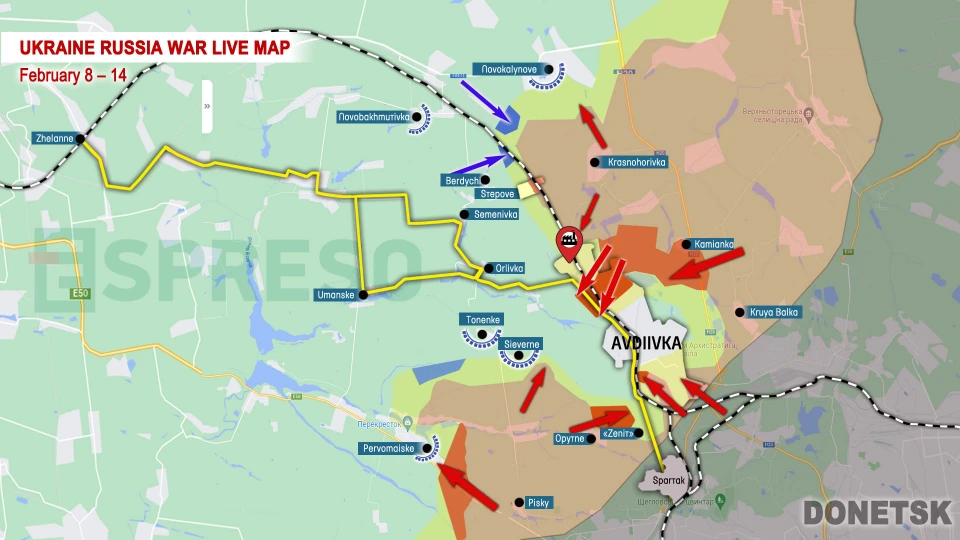
Avdiivka's defining trial: toughest week in defense history. Serhiy Zhurets column
This week, Avdiivka faces its toughest defense yet as the Russian army targets the vital logistical route from the Coke Plant to the city, severing the Avdiivka-Lastochkine road and drastically limiting Ukrainian logistics
Russia's terrorist missile attack on Ukraine on February 15
The occupying Russian army carried out another terrorist attack on Ukraine using long-range missiles of various types overnight on February 15. The attack followed a fairly standard pattern, employing both cruise and ballistic missiles. Cruise missiles launched from Tu-95 bombers traveled long distances across Ukrainian territory.
The Russian army keeps trying to complicate the routes of its missiles to find weaknesses in Ukrainian air defense. According to information from the Ukrainian Air Force, out of 26 missiles of various types, the air defense forces shot down half of them. In particular, 14 out of 18 cruise missiles were destroyed. Also, the air defense forces managed to shoot down all 6 ballistic missiles on the approach to Kyiv. There is confirmation that one Kalibr missile was shot down, and there is likely also confirmation of the DPRK missile debris. It is worth recalling that this is the 5th massive attack on the territory of Ukraine in 2024. The previous missile attack took place on February 7. Then, in addition to the list of all the missiles we mentioned, Russia used its Zircon hypersonic missile. That is why strengthening Ukrainian air defense remains an important challenge. This was discussed at the Ramstein meeting.
Situation in Avdiivka is extremely critical
The next active phase of hostilities in the Avdiivka direction has been ongoing since October 9th of last year. At that time, the Russian forces attempted attacks with wide fronts from the north and south, targeting the Severnyi and Stepovy sectors. Their attempts were unsuccessful, and the enemy began to reorganize and accumulate forces and resources. Currently, in the Avdiivka direction, the occupiers have amassed over 50,000 personnel and more than 12 different regiments and brigades, which are currently attempting to attack Avdiivka.
According to British intelligence, the Russian forces have suffered losses of over 25,000 personnel specifically on the Avdiivka front. However, they continue rotations and leverage their artillery and aviation superiority. The most intense events began in early February, following some successes for the Russian troops in the north of Avdiivka and in the south near the Tsarska Okhota complex.
This week appears to be the most challenging in the Avdiivka defense history, as the invading Russian army has concentrated all their forces on cutting off the main logistical route that runs past the Coke Plant to Avdiivka. The Russian troops managed to physically sever the Avdiivka-Lastochkhine route, reaching the Industrial Avenue. This has effectively halved Ukrainian logistical capabilities to Avdiivka.
 Hostilities in the Avdiivka sector over February 8-14
Hostilities in the Avdiivka sector over February 8-14
Now Ukrainian forces are holding the line. A few days ago, the 3rd Separate Assault Brigade was redeployed to this section of the front. I think this brigade was sent to this section of the front by the decision of the Ukrainian Armed Forces Commander-in-Chief Oleksandr Syrskyi.
According to Brigade Commander Andriy Biletskyi, the situation in the city is extremely critical. Certain battalions of the 3rd Separate Special Forces Brigade conducted raids into Russian-occupied areas of Avdiivka. The Russian forces operating in the area where the 3rd Separate Special Forces Brigade is deployed consist of seven brigades. Biletskyi also reported that the situation in Avdiivka remains threatening and unstable. Deputy Commander of the 3rd Detached Special Forces Brigade, Maksym Zhorin, commented that the tasks the brigade units are executing are even more challenging than they could have imagined because the battles in Avdiivka are many times more intense than those for Bakhmut. The Russian army has a significant number of personnel surrounding them from all sides. Finally, an engineer from the 3rd Separate Special Forces Brigade stated that the overall situation closely resembles the Bakhmut defense, where the brigade's infantry had to engage in defense immediately upon arrival.
Amid these reports, information from the spokesperson of the Joint Forces Operation Tavria emerged. According to him, there is maneuvering by Ukrainian units in Avdiivka, sometimes to retreat to more advantageous positions and sometimes to reclaim lost positions. Supply, logistics, and evacuation from Avdiivka are complicated. Looking at the map, one can see that there are only three roads leading to Avdiivka: Orlivka-Lastochkine, partially blocked by the Russian troops; Lastochkine-Severne, and Severne-Avdiivka. All these roads converge in the north of Avdiivka, in the Khimik area. These roads are the main logistical routes for supplying our troops. In my opinion, the 3rd Separate Special Forces Brigade should now either push back or hold the Russian troops advance towards the logistical routes and ensure the withdrawal of Ukrainian units from the eastern pocket, which will enable Ukraine to preserve personnel. Since we understand very well that a counterattack by the Ukrainian Armed Forces requires more forces than what a single brigade can provide.
Thermal camouflage cloak for protection against thermal surveillance devices
Kostiantyn Boriak, Senior Researcher at the Naval Armaments Development Department of the Scientific Research Center within the Ukrainian Armed Forces Naval Forces Institute, stated that their center maintains ongoing communication with representatives from the Ministry of Defense and specialists involved in camouflage equipment development. At present, there are no specific requirements established for the production of thermal camouflage cloaks. This is due to the absence of a universal cloak suitable for various units within the Ukrainian Armed Forces.
According to Boriak, they have been involved in developing thermal camouflage cloaks specifically tailored for units such as the Main Intelligence Directorate, Special Operations Forces, Reconnaissance and Sabotage Units, snipers, and so forth. Such cloak designs are not typically suited for Naval Infantry units. Boriak emphasized that the design of thermal camouflage cloaks can vary depending on the specific operational requirements of the units tasked with their use.
Kostiantyn Boriak emphasized that the distinctiveness of their cloak lies in its ability to facilitate thermal exchange with the surrounding environment. However, this thermal exchange occurs so rapidly that it remains undetectable to thermal surveillance devices. According to Boriak, military personnel have responded very positively to these thermal camouflage cloaks. However, currently, there is insufficient funding for production to meet all the needs and requests from the military.
- News














































